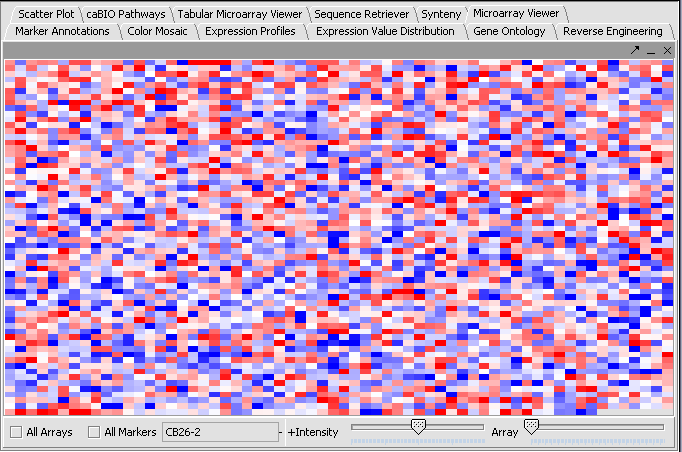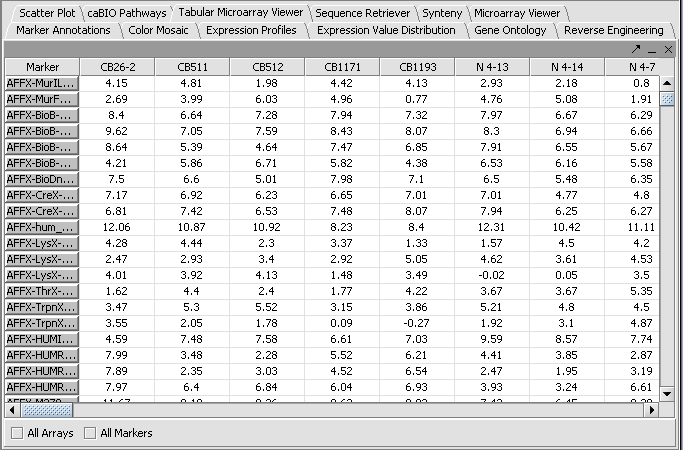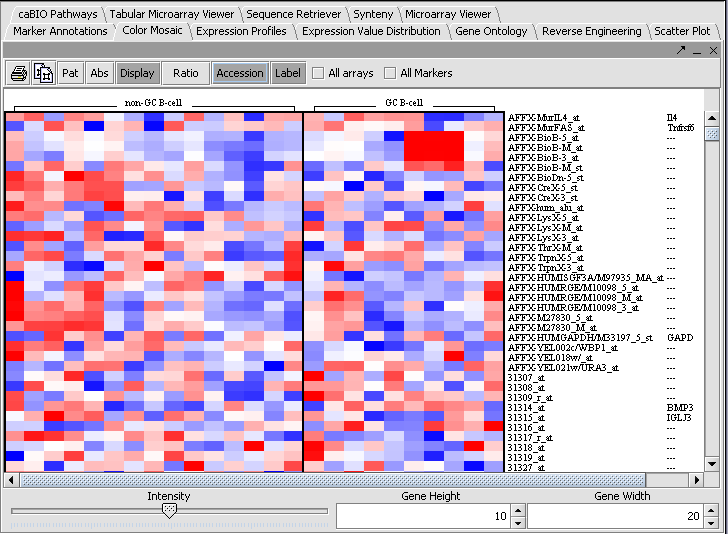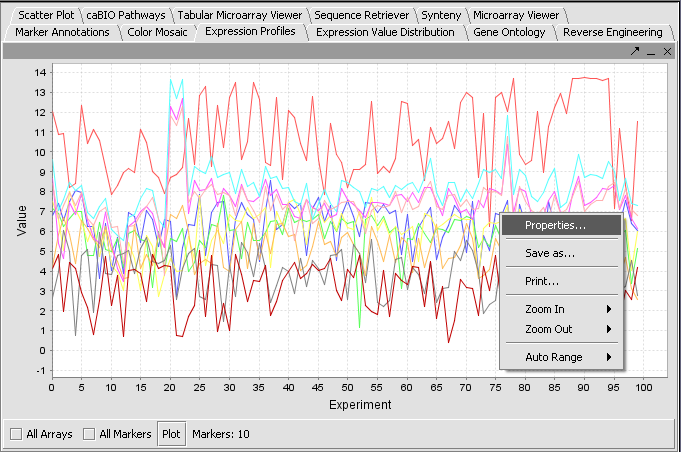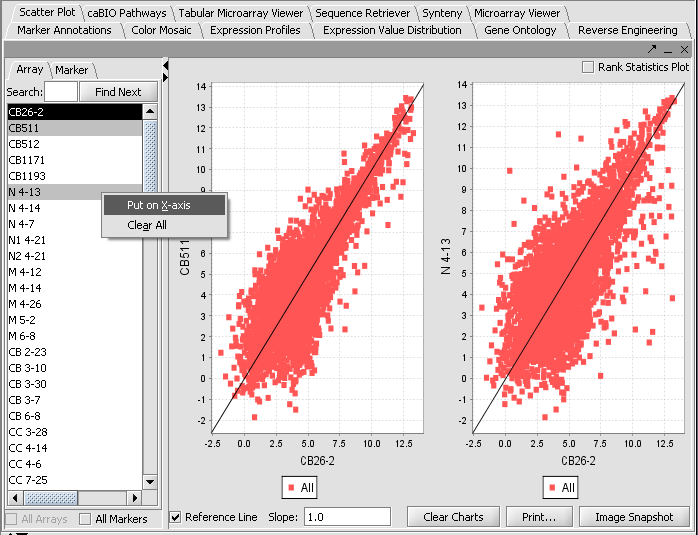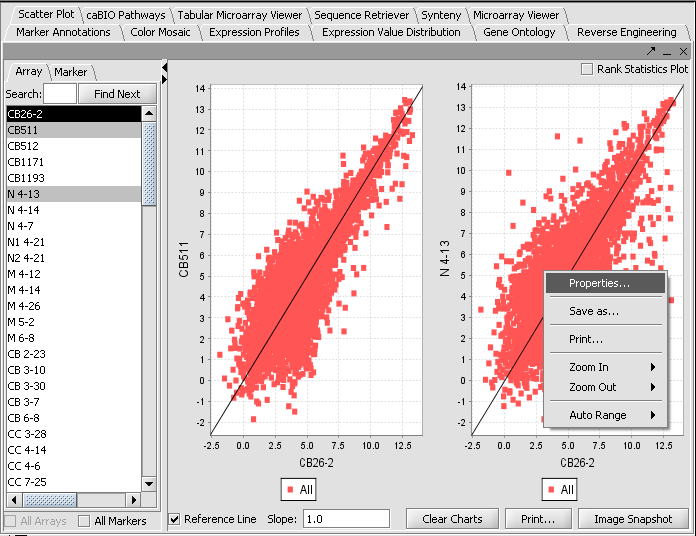Microarray Dataset Viewers
|
Home | Quick Start | Basics | Menu Bar | Preferences | Component Configuration Manager | Workspace | Information Panel | Local Data Files | File Formats | caArray | Array Sets | Marker Sets | Microarray Dataset Viewers | Filtering | Normalization | Tutorial Data | geWorkbench-web Tutorials |
Analysis Framework | ANOVA | ARACNe | BLAST | Cellular Networks KnowledgeBase | CeRNA/Hermes Query | Classification (KNN, WV) | Color Mosaic | Consensus Clustering | Cytoscape | Cupid | DeMAND | Expression Value Distribution | Fold-Change | Gene Ontology Term Analysis | Gene Ontology Viewer | GenomeSpace | genSpace | Grid Services | GSEA | Hierarchical Clustering | IDEA | Jmol | K-Means Clustering | LINCS Query | Marker Annotations | MarkUs | Master Regulator Analysis | (MRA-FET Method) | (MRA-MARINa Method) | MatrixREDUCE | MINDy | Pattern Discovery | PCA | Promoter Analysis | Pudge | SAM | Sequence Retriever | SkyBase | SkyLine | SOM | SVM | T-Test | Viper Analysis | Volcano Plot |
Contents
Outline
In this section, various tools for visualizing microarray expression data will be introduced. Available options for each component will be depicted.
The visualizers displayed here are:
- Microarray Viewer
- Tabular Microarray Viewer
- Color Mosaic
- Expression Profiles
- Scatter Plot
The options for several of the components are set from the application toolbar preferences menu, which will also be explained.
Overview
Visualization tools provide a view of the microarray datasets under investigation and can be used e.g. for ascertaining the quality of the data. Activating marker and array/phenotype sets (Tutorial - Data Subsets) can be used to restrict the number of markers/arrays displayed. The images created can be saved and exported. A more detailed description of how to manipulate visualization components is given in the online help.
Microarray Viewer
Used to inspect data from each separate microarray using the Array scroll bar. Note that the markers (probes or probesets) are displayed in the order they appear in the dataset, and the image is not a physical representation of the microarray layout. The image can be saved into the Project Folders component under its parent dataset by right-clicking and selecting Save Image.
The viewing preference shown here is the "relative" display mode. See below (Preferences) for switching between relative and absolute display modes.
Tabular Microarray Viewer
Presents the numerical values of the expression measurements in a table format. One row is created per individual marker/probe and one column per microarray.
Color Mosaic
Heat maps for microarray expression data, organized by phenotypic or gene groupings. The Display button causes the image to be displayed. The Label and Accession buttons display the marker name and accession number to the right of each row. The buttons Pat, Abs and Ratio are not currently used.
Expression Profiles
For each active marker (default is all), a line showing the expression value vs array is graphed. Each marker is displayed with a separate color line. The Plot button must be pushed to draw the display. If a subset of markers has been activated, the number active is shown adjacent to the Markers label. Right-click options are shown.
Scatter Plot
A pairwise (array vs. array and marker vs. marker) comparison and plotting of expression values. The first marker selected serves as the x-axis reference, shown with a dark background; this can also be set by right-clicking and selecting the x-axis marker as shown). Subsequent arrays selected are plotted against this reference in different sub-images. Up to six sub-images can be created. Right-click options are shown in the second picture.
Preparation
Load a microarray dataset, for example the file webmatrix_quantile_log2_dev1.2_mv0.exp that is included with the geWorkbench tutorial data Download.
Viewing a dataset
- In the View Area at the top-right section of the interface, select any viewer described above, for example the Microarray Viewer component.
- On several of the components, the All Markers and All Arrays checkboxes can be used to override the effects of activated sets, should they be in use. When no sets are activated, all markers or arrays will be used.
Preferences
The Preferences selection in the Tools menu allows users to specify how certain aspects of the system will behave. Once the preferences are set, they are persistent between application sessions.
Modifying Settings
- From the main menu, click on Tools>Preferences.
- In the Preferences pop-up window, you can define settings for:
- Text Editor: The editor selected will be used to open and inspect data sets loaded in a project. Notepad is the default setting.
- Visualization: The color scheme to be applied to color mosaic images.
- Absolute: (default) Let M = max{|min|, |max|} over all expression measurements, across all arrays. If expression value x > 0, assign it the red spectrum x / M * 256. If expression value x is negative, assign it to the green spectrum -x / M * 256.
- Relative: This is similar to the setting for Absolute, but each marker is mean-variance normalized first. A Red-Blue color scheme is used.
- Genepix Value Computation: You can specify how to compute the value displayed for a Genepix array. The default setting is Option (Mean F635 - Mean B635) / (Mean F532 - Mean B532).
- Click on OK.
Notes
- The Relative selection for the the Microarray Viewer preference will give odd-looking results if only a small number of arrays are loaded.
- Changing the Microarray Viewer relative/absolute preference will not take effect until the next time a data set is loaded.
